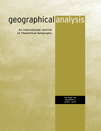
GEOGRAPHICAL ANALYSIS
Scope & Guideline
Connecting Research and Application in Geography
Introduction
Aims and Scopes
- Spatial Modeling and Analysis:
The journal emphasizes the development and application of spatial statistical models, including geographically weighted regression and spatial econometric models, to understand complex spatial relationships and patterns. - Geographic Information Systems (GIS) and Technology:
A core focus is on the use of GIS technologies for data collection, analysis, and visualization, enabling researchers to explore spatial data in innovative ways. - Socioeconomic and Environmental Contexts:
Research often examines the interplay between spatial phenomena and socioeconomic factors, addressing issues like urban inequality, accessibility, and environmental impacts. - Methodological Innovations:
The journal promotes methodological advancements in geographical research, including machine learning applications, hybrid models, and new statistical techniques for spatial data analysis. - Public Health and Accessibility:
There is a consistent focus on public health issues, particularly the spatial analysis of health data, accessibility to services, and the impact of environmental factors on health outcomes.
Trending and Emerging
- Integration of Machine Learning:
There is a growing trend towards the application of machine learning techniques in spatial analysis, particularly for predictive modeling and handling large datasets in urban and regional studies. - Spatial Accessibility and Inequity:
Recent publications have increasingly focused on spatial accessibility, examining how geographic factors influence access to services and the implications for social equity, particularly in urban contexts. - Health Geography:
The journal has seen a surge in research related to health geography, with studies exploring the spatial dynamics of health outcomes, particularly in relation to the COVID-19 pandemic and other public health crises. - Data Privacy and Ethical Considerations:
Emerging themes include the ethical implications of using geospatial data, especially concerning privacy and data protection, reflecting broader societal concerns around data use. - Dynamic Spatial Network Analysis:
There is an increasing emphasis on analyzing dynamic spatial networks, such as transportation and communication networks, to understand their influence on urban development and mobility patterns.
Declining or Waning
- Traditional Spatial Analysis Methods:
There has been a noticeable decrease in papers employing traditional spatial analysis techniques without innovative adaptations, as newer methods and technologies gain prominence. - General Environmental Studies:
Research that broadly addresses environmental issues without a clear spatial or methodological focus appears to be less common, possibly overshadowed by more specific studies that leverage advanced analytical techniques. - Static Land Use Studies:
The prevalence of static assessments of land use and urban planning has diminished, as the journal increasingly favors dynamic analyses that consider temporal changes and interactions.
Similar Journals
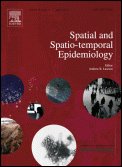
Spatial and Spatio-Temporal Epidemiology
Mapping Health: Where Space Meets TimeSpatial and Spatio-Temporal Epidemiology is a premier journal dedicated to advancing the understanding of spatial patterns and temporal dynamics in epidemiological research. Published by ELSEVIER SCI LTD in the United Kingdom, this journal utilizes a robust interdisciplinary approach, blending methodologies from epidemiology, geography, and environmental science. With an impressive impact factor and categorized in the top quartiles for its fields—Q2 in Epidemiology and Q1 in Geography, Planning and Development (2023)—this journal excels in providing high-quality insights relevant to both academic researchers and public health professionals. The journal supports open access options, enhancing the dissemination and impact of scholarly articles. Since its inception in 2009, Spatial and Spatio-Temporal Epidemiology has published a myriad of studies that contribute significantly to understanding the geographical and temporal aspects of diseases, thereby serving as a crucial resource for anyone invested in improving public health outcomes and addressing infectious diseases globally.
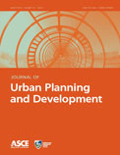
JOURNAL OF URBAN PLANNING AND DEVELOPMENT
Fostering Sustainable Growth in Urban Landscapes.The JOURNAL OF URBAN PLANNING AND DEVELOPMENT, published by the ASCE-AMER SOC CIVIL ENGINEERS, stands as a pivotal platform in the realms of urban studies, civil and structural engineering, and development. With an ISSN of 0733-9488 and E-ISSN of 1943-5444, this journal aims to disseminate high-quality research addressing critical urban planning challenges, fostering innovative solutions, and contributing to sustainable development practices. Spanning from its inception in 1979 to the anticipated issues up to 2024, the journal proudly occupies the Q2 category across multiple disciplines, including Civil and Structural Engineering, Development, Geography, Planning and Development, and Urban Studies. Its noteworthy Scopus rankings reflect its influence, notably being positioned in the 76th percentile in Urban Studies. With no open access options currently available, the journal remains a selective forum for scholarly discourse, attracting researchers, professionals, and students eager to engage with cutting-edge developments in urban planning and design.
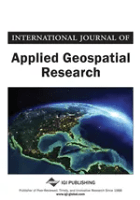
International Journal of Applied Geospatial Research
Empowering multidisciplinary contributions in geospatial research.International Journal of Applied Geospatial Research is an esteemed publication dedicated to advancing the field of geospatial research. Published by IGI Global, this journal provides a platform for innovative studies from 2010 to 2024 that encourage multidisciplinary contributions across Earth and planetary sciences and geography. While currently not offering open access, the journal's focus on applied research ensures that it remains highly relevant to both academics and industry professionals alike. With an ISSN of 1947-9654 and an E-ISSN of 1947-9662, it has been indexed in various databases, reflecting its emerging significance with rankings such as Q4 in Earth and Planetary Sciences and Geography according to Scopus, placing it at the intersection of critical research and practical application. Researchers, professionals, and students can expect insightful articles that enhance understanding and drive innovation in geospatial applications essential for informed decision-making in a rapidly changing world.
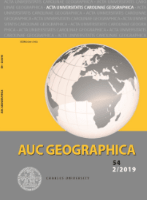
AUC Geographica
Fostering Innovative Research in Earth and Environmental StudiesWelcome to AUC Geographica, a distinguished journal published by CHARLES UNIV PRAGUE, KAROLINUM PRESS, focusing on the expansive and interdisciplinary fields of Earth and Planetary Sciences, as well as Geography, Planning, and Development. With an ISSN of 0300-5402 and an E-ISSN of 2336-1980, this Open Access journal has been freely accessible since 2010, allowing researchers, professionals, and students to engage with high-quality scholarly articles without barriers. As of 2023, it holds a Q4 ranking in its respective categories, reflecting its commitment to contributing to the academic discourse despite competitive landscapes. Located in Prague, Czech Republic, at OVOCNY TRH 3/5, PRAGUE 1 116 36, AUC Geographica aims to foster collaboration and innovative research in the multifaceted relationships between human activities and the natural environment. With a publication history spanning from 1975 to 2024, this journal continues to be a vital resource for those seeking to advance knowledge and explore new dimensions in geography and Earth sciences.
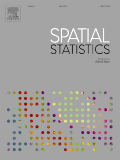
Spatial Statistics
Pioneering Research in Spatial StatisticsSpatial Statistics is a premier journal published by ELSEVIER SCI LTD, focusing on innovative methodologies and applications in the realm of statistical analysis within spatial contexts. With an ISSN of 2211-6753, the journal has established itself as a significant contributor in its field since its inception in 2012, and continues to thrive, with its next volume projected through 2024. It holds a respectable Q2 ranking across several categories, including Computers in Earth Sciences, Management, Monitoring, Policy and Law, and Statistics and Probability, affirming its impact and relevance to researchers and professionals alike. The journal's commitment to publishing high-quality research enables scientists to advance understanding of spatial phenomena, facilitating informed decision-making in various applications ranging from environmental science to urban planning. As part of a robust academic community, Spatial Statistics invites submissions that push the boundaries of conventional statistical techniques, ensuring that the latest findings contribute significantly to the discipline's body of knowledge.

Revue Internationale de Geomatique
Connecting Disciplines Through Geospatial InnovationRevue Internationale de Geomatique (ISSN: 1260-5875, E-ISSN: 2116-7060) is a prestigious journal published by TECH SCIENCE PRESS, dedicated to advancing the field of geomatics. This journal serves as a vital platform for disseminating significant research findings, cutting-edge methodologies, and innovative applications within the realm of spatial data and technology. With an emphasis on interdisciplinary studies, it fosters collaboration among researchers, professionals, and students across various domains, including environmental science, urban planning, and geographic information systems (GIS). Although not an open-access journal, Revue Internationale de Geomatique maintains a rigorous peer-review process ensuring the publication of high-quality articles that contribute to the evolving landscape of geomatics. Given its relevance and commitment to scholarly excellence, this journal is a crucial resource for advancing knowledge and practices in the ever-growing field of spatial information science.
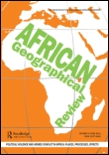
African Geographical Review
Navigating Earth-Surface Processes Across the African ContinentAfrican Geographical Review is a pivotal academic journal published by Routledge Journals, Taylor & Francis Ltd, whose mission is to advance knowledge and understanding of geographical dynamics across the African continent. With an ISSN of 1937-6812 and an E-ISSN of 2163-2642, this journal consistently delivers high-quality research, showcasing innovative perspectives and interdisciplinary approaches within the fields of Earth-Surface Processes and Geography, Planning and Development. Recognized in 2023 with a Q2 ranking in these categories, it ranks #231 out of 821 in Social Sciences and #63 out of 179 in Earth and Planetary Sciences according to Scopus metrics, reflecting its substantial impact and relevance. Featuring research that spans various geographic themes, the journal not only champions academic inquiry but also fosters a deeper understanding of spatial and environmental challenges unique to Africa. Engaging with a diverse audience of researchers, professionals, and students, the African Geographical Review serves as an indispensable resource for those committed to enhancing geographic scholarship and informing sustainable development practices across the continent.

Cadernos de Geografia
Innovating Insights into Contemporary Geographical IssuesCadernos de Geografia is a distinguished biannual journal published by UNIVERSIDADE DE COIMBRA, FACULDADE DE LETRAS, dedicated to the field of geography and related social sciences. With its ISSN 0871-1623 and E-ISSN 2183-4016, this journal has been a prominent platform for the dissemination of high-quality research since it became open access in 2012. Situated in Coimbra, Portugal, it aims to foster academic excellence by providing an inclusive space for innovative studies that explore contemporary geographical issues. Cadernos de Geografia encourages submissions that address diverse aspects of geography, ranging from environmental studies to urban planning, making it an invaluable resource for researchers, professionals, and students alike. As a part of the growing trend in open-access publishing, it enhances the global reach and accessibility of geographical research, thereby contributing to the enrichment of knowledge in the field.
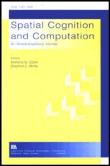
Spatial Cognition and Computation
Advancing Knowledge in Spatial IntelligenceSpatial Cognition and Computation is a premier academic journal published by TAYLOR & FRANCIS INC, focusing on the interdisciplinary fields of spatial cognition and computational analysis. With its ISSN 1387-5868 and E-ISSN 1542-7633, the journal has established itself as an authoritative source of innovative research since its inception in 2000. It is esteemed in various categories, receiving Q2 rankings in Computer Graphics and Computer-Aided Design, Computer Vision and Pattern Recognition, and Earth-Surface Processes, showcasing its impact in these dynamic fields. Additionally, it ranks in the Q3 tier for Experimental and Cognitive Psychology. The journal serves as a crucial platform for researchers, professionals, and students to explore cutting-edge developments and foster collaboration across disciplines. Although it is not currently an open-access journal, readers can access articles through library subscriptions or individual purchases, ensuring that its impactful research is widely disseminated in the academic community.
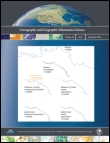
Cartography and Geographic Information Science
Bridging Theory and Practice in Geographic InformationCartography and Geographic Information Science is a premier journal published by Taylor & Francis Inc, focusing on the interdisciplinary realms of geography, planning, and technological innovation. With an impressive impact factor and ranking in the top quartiles across various categories, including Q1 in Geography, Planning and Development and Q2 in Civil and Structural Engineering, this journal serves as an essential resource for researchers, professionals, and students alike, promoting cutting-edge research and advancements in cartography and geographic information systems. The journal disseminates high-quality articles that explore both theoretical and practical aspects of geographic information, aiming to enhance the understanding and application of spatial data. As the field evolves, Cartography and Geographic Information Science remains a vital forum for innovation and scholarly dialogue, offering accessible content to a global audience. With its commitment to rigor and relevance, it plays a critical role in advancing the landscapes of geography and environmental sciences.